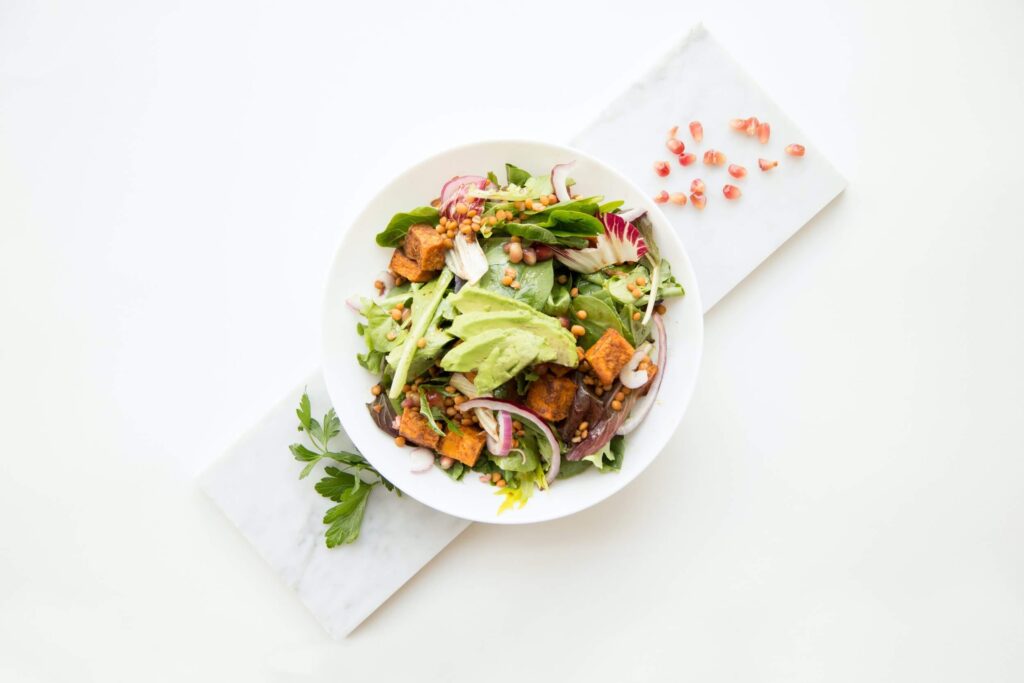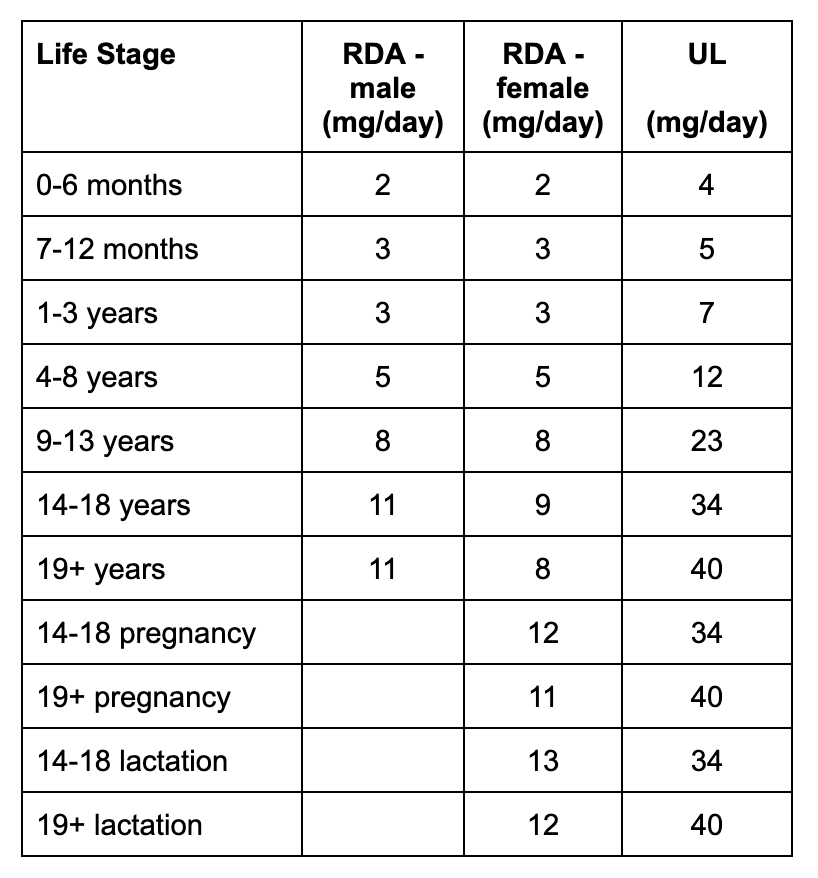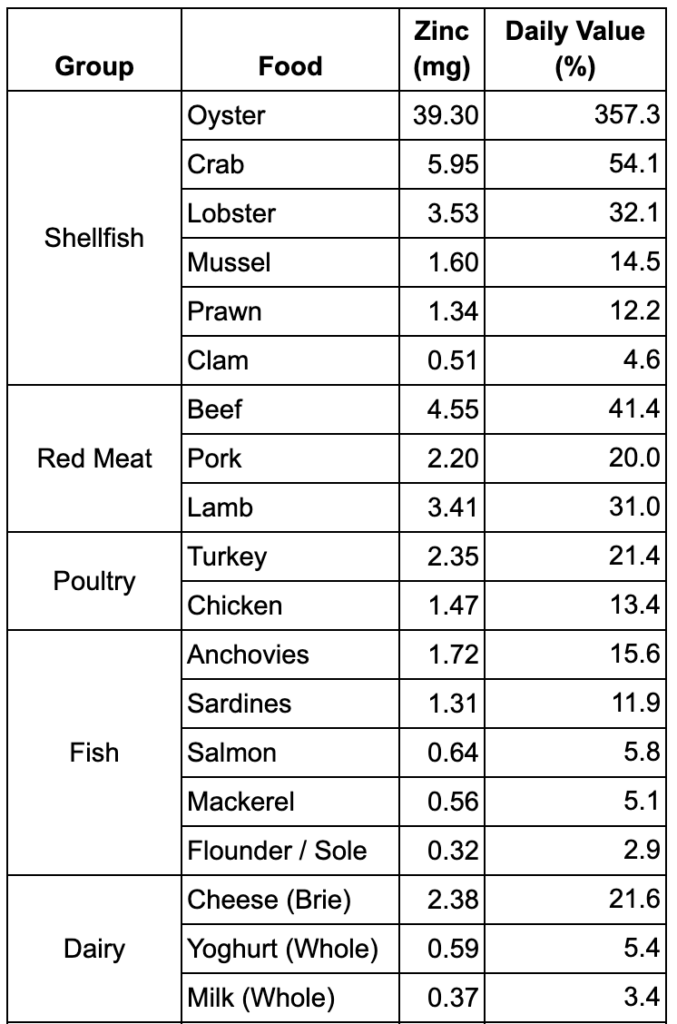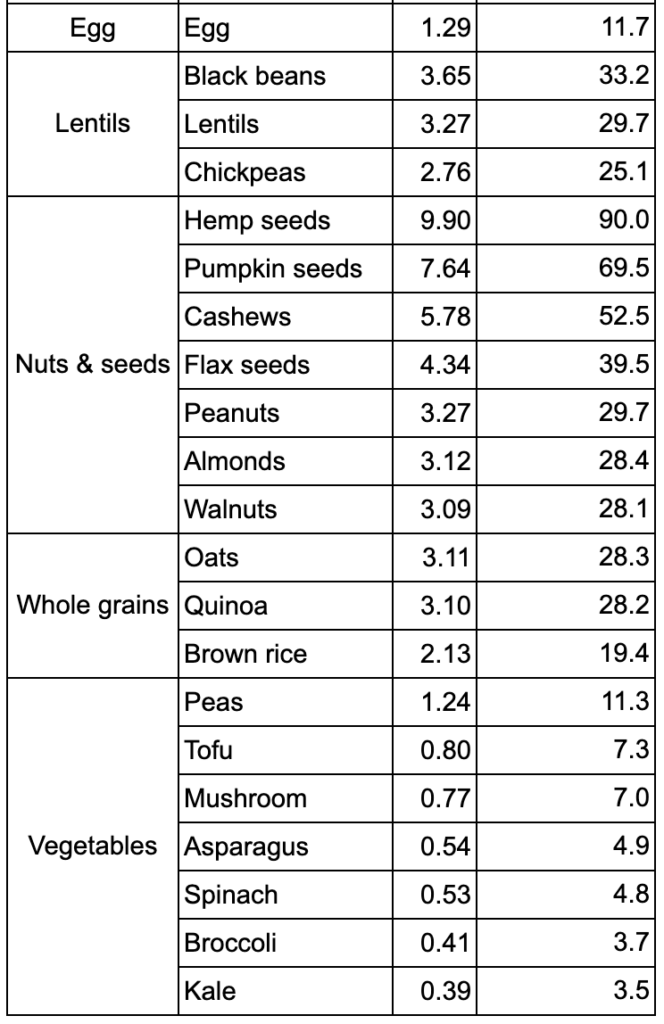During the pandemic, as scientists raced to formulate and deliver the vaccine, misinformation circulated about ways to fend off COVID-19. Amidst this fake news, zinc emerged as one way to help fight the deadly virus. Spoiler: it doesn’t, as the National Institute of Health (NIH) and World Health Organisation (WHO) confirm.
While it is too early to ascertain the benefits of nutrients such as zinc in the treatment of COVID-19, is there a link between zinc and our immunity in general? Zinc plays a vital role in maintaining our overall health and is responsible for several functions in our bodies.
Let us explore the properties of zinc that make it indispensable to us, the consequences of zinc deficiency and natural sources of zinc that you can incorporate into your diet.

Highlights
- Zinc is an essential micronutrient for our overall health, controlling cell growth and development,
- Zinc controls our immune and inflammation response, accelerates wound healing and can slow the progression of age-related diseases,
- To reach your recommended level of zinc, incorporate zinc-rich foods into your diet. Vegetables, legumes and grains have lower zinc absorption, while animal proteins such as shellfish contain high amounts of zinc.
What is zinc?
First, let’s simplify the chemistry of it. Zinc is an element from the periodic table—a low melting metal that forms part of the earth’s crust. Commercially, it is used in galvanising (weatherproofing) iron and steel. Zinc oxide is an over-the-counter dermatological treatment for burns, bedsores, diaper rash and eczema.
Apart from its industrial and external applications, zinc plays an essential role in our bodies. It is a micronutrient, which means you only require small amounts of it every day. After iron (3-4g), zinc is the most abundant trace mineral (2-3g) in the body, primarily residing in skeletal muscle (57%), but present in bones (29%), skin (6%), the liver (5%) and other organs (3%).
Zinc aids in cell growth and division and acts as a catalyst for metabolic activity involving enzymes, proteins and DNA. It is crucial for growth and development during pregnancy, childhood and adolescence. Vital to our immunity and metabolic health, zinc plays an essential role in determining our overall well-being throughout our lives.
What role does zinc play in our health? What are its benefits?
Zinc supports a wide array of functions in the body:
1. Immune system function:
Ideal immune responses to harmful pathogens that make their way into the body are fast and specific. Zinc supports the growth and function of immune cells and regulates immune homeostasis (a state of internal equilibrium). It modulates innate and adaptive immune functions—think of innate as the body’s first line of defence (mucous membranes, skin) and adaptive as the last (antibodies).
Zinc regulates signalling in intracellular pathways controlling cell maturation, differentiation and division to facilitate proper immune function. The secretion of cytokines—small proteins that control immune activity—is affected by zinc deficiency. Cytokines affect the growth of blood cells and other cells that aid the body’s immune response.
Lower than normal zinc levels impair the activity of these basic messengers of the immune system. Our bodies require zinc to mature and activate T lymphocytes (T cells)—types of white blood cells from the bone marrow responsible for fighting harmful viruses and infections.
Insufficient zinc levels reduce lymphocyte proliferation (build-up) and slow down T cell, neutrophil and macrophage activity (part of innate immune response to harmful microorganisms such as viruses and bacteria). Besides zinc, minerals such as iron and copper are essential for proper immune function.
2. Reduces inflammation
Damaged tissues elicit a zinc-driven immune response in our bodies. Zinc is responsible for inflammatory signalling and induces the expression of inflammatory cytokines and other immune cells. These cells migrate to the afflicted area and begin to eliminate harmful pathogens.
However, chronic inflammation can lead to oxidative stress. Oxidative stress occurs when there is an imbalance in free radical and antioxidant defences, causing damage to cells. Antioxidants play an important role in mitigating oxidative stress. Zinc has several antioxidant properties. It reduces the production of free radicals, increases the activation of antioxidant proteins, molecules and enzymes and reduces the activity of oxidant-promoting enzymes.
A 2014 study by oncologist Ananda Prasad examines the effect of zinc on inflammatory cytokines and oxidative stress biomarkers. Biomarkers for both were lower in zinc-sufficient cells when compared to zinc-deficient cells. Oxidative stress and chronic inflammation are linked to numerous chronic diseases such as cancer, cardiovascular disease, metabolic syndrome and neurodegeneration.
However, it is important to note that zinc does not prevent the onset of these diseases, and more research is needed to understand the correlation.
3. Accelerates wound healing:
Wound healing, inflammation and our immune response are closely intertwined. Successful wound healing follows a series of coordinated internal processes—coagulation (blood clotting), inflammation, angiogenesis (new blood vessel formation), new tissue formation and fibrosis (scar formation). Zinc plays a pivotal role at every stage of this process by eliciting the body’s inflammation and immune response.
To repair damaged cells, zinc facilitates the production of new cells that help with repair and restoration. It assists in mucosal membrane repair and supports the skin by fighting off bacteria and infection. Serum zinc levels temporarily decrease with trauma or injury, but zinc levels rise at the site of injury. Hospitals use zinc topically to treat burns, ulcers and other skin injuries.
4. Metabolism and enzyme function:
Approximately 10% of mammalian cells bind to zinc at the molecular level. Zinc plays several roles in the biochemical and hormonal functions of various organs. It is absorbed in the small intestine before being distributed across the body and is lost primarily through excretion.
Depending on zinc uptake and levels, our gastrointestinal absorption and excretion adjust zinc levels according to the body’s physiological needs. Maintaining a constant state or equilibrium of cellular zinc is known as zinc homeostasis, which is essential for our survival. Zinc homeostasis is controlled by over 24 zinc-transporting proteins that facilitate everything from thyroid, liver and kidney function to our central nervous system.
Zinc modulates insulin activity by stimulating secretion from cells in the pancreas, affecting glucose metabolism. It aids in manufacturing proteins and is vital for DNA synthesis, RNA transcription (copying a segment of DNA into RNA) and cell survival. Zinc dependence is observed in all classes of enzymes. Zinc ions are a vital cofactor (helper/auxiliary) for over 3000 proteins and enzymes required for cell membrane repair, cell proliferation, growth and proper system function.
In some cases, it acts as a catalyst; in others, zinc helps maintain enzyme structure. Enzymes that help us break down carbohydrates and develop our senses of taste and smell depend on zinc to operate normally. Intracellular signalling pathways can be altered due to limited zinc availability, affecting cellular growth, differentiation and function.

5. Development in children:
Zinc is required for normal skeletal growth and bone homeostasis. It is especially important during periods of rapid growth—pregnancy, infancy and puberty—during which zinc requirements are highest. During adolescence, zinc requirements peak in girls between the ages of 10 and 15 years and boys between 12 and 15 years.
Adolescents may require additional zinc even after their growth spurt ceases. Researchers conducted a study on lab rats to determine zinc’s role in bone quality. Rats were fed a zinc-deficient diet for 42 days, after which they had lower body weight. Their bones exhibited lower protein and mineral content and reduced concentrations of essential bone tissue.
After administering zinc, their bone volume and mineral density improved. However, more research is required to understand the full extent of zinc’s involvement in bone growth and maintenance. The role of zinc in the development of cognition, learning and memory has not been fully explored, but zinc influences a child’s mental development.
Zinc-deficient children exhibit delayed cognitive development, poor motor skills, inactivity and poor attention. Combined, these factors result in stunted academic advancement and arrested development.
6. Reduces risk of age-related diseases:
Age-related macular degeneration (AMD) is a leading cause of vision loss and affects 170 million people worldwide. An eye condition of blurred or reduced central vision, it occurs primarily in adults over the age of 50. The macula, a region of tissue in the retina responsible for sharp, straight-ahead vision, becomes thinner and damaged as we age.
Studies reveal that zinc can delay the progression of AMD. Many chronic diseases can be partly attributed to a lack of zinc. Zinc’s antioxidant properties mean it is an inhibitor of oxidative stress. Chronic inflammation and heightened oxidative stress are linked to rheumatoid arthritis, atherosclerosis (plaque buildup in arteries), metabolic syndrome and diabetes.
Zinc’s inhibitory response to inflammation and oxidative stress is clear, but more research is needed to determine its true health benefits in chronic disease prevention.
7. Skin health and acne treatment:
Zinc is omnipresent in our skin and plays a role in maintaining skin health. The skin undergoes constant renewal—a life cycle where old skin dies as new skin replaces it. This places a burden on zinc-assisted enzymes and proteins that govern this process.
Acne vulgaris, simply known as acne, affects around 9.4% of the global population, according to a 2015 study. Lesions are formed on the skin after hair follicles become clogged with bacteria, dead skin, dirt or oil. Acne is most common in post-pubescent teens, especially boys.
Zinc is administered orally or topically (as creams) to reduce acne scarring. Moghaddam et al. conducted a study to investigate acne and corresponding blood (serum) zinc levels in patients. There was no difference in serum zinc between the acne-affected and healthy subjects.
However, severity and type of acne lesions were correlated with lower serum zinc levels—in patients with severe acne, zinc levels decreased. Numerous studies have investigated the relationship between zinc levels and acne vulgaris, with contradictory findings. More research is needed to understand zinc’s influence on this condition.

What are the signs of zinc deficiency?
A zinc deficiency is difficult to diagnose as there is no reliable biomarker to measure zinc status. First, we must understand our daily zinc requirements. Recommended daily allowance (RDA) changes with age, while tolerable upper intake level (UL) is the maximum we should be ingesting in a day. The chart below indicates RDA and UL values during different stages of our lives:

In 2011, 1.1 billion people were at risk of zinc deficiency due to inadequate dietary supply. The estimated number today stands at 2 billion. Malnourished children in developing countries have insufficient food and animal protein intake and suffer from diseases such as pneumonia, malaria and diarrhoea. Increased losses of zinc during bouts of these illnesses translate to poor zinc absorption. The key to efficient zinc absorption is the concept of bioavailability.
Bioavailability refers to the fraction of a substance that becomes available to its biological destination (bioavailability of 50% equates to 50% absorption of a substance, and so on). Bioavailability of zinc is low in the diets of developing nations that typically include grains, pulses and legumes—foods high in phytic acid or phytates.
Phytates are an inhibitor of zinc absorption. Similarly, staples of the vegetarian diet include grains, legumes, nuts and tubers (potatoes, carrots etc.)—all containing phytates, which bind to metals (such as zinc) to form an insoluble compound reducing zinc bioavailability. This makes vegans or vegetarians more susceptible to zinc deficiency as plant foods have lower bioavailability than animal foods. Proteins have a “positive influence” on zinc absorption, increasing protein intake. Consumption of animal protein can improve the bioavailability of zinc from plant foods—the protein either binds to phytates or releases amino acids to maintain zinc solubility.
Due to its role in cell growth and division, zinc is of high importance to a developing foetus. Consequently, pregnant or lactating women have a higher zinc requirement since they need to supply the micronutrient to the infant for the first six months of life. Breast milk has low zinc content (~0.1mg/100ml), and exclusively breastfed children can suffer from a deficiency. Infants older than six months are given formula along with breast milk to help reach their RDA.
Several other demographics have a higher risk of zinc deficiency, usually those with zinc malabsorption. People with diabetes, cancer or gastrointestinal conditions such as Crohn’s disease or ulcerative colitis, patients with chronic kidney or liver disease and alcoholics also suffer from poor zinc absorption. The elderly exhibit inadequate zinc intake even in developed countries. This could be due to reduced consumption of zinc-rich foods such as red meat.
Symptoms of zinc deficiency include:
- Decreased appetite
- Decreased immunity
- Delayed wound healing
- Depressed mood
- Diarrhoea
- Hair loss
- Impotence in men
- Loss of taste or smell
- Rough/sore skin and eyes
- Weight loss
Children or adolescents may experience:
- Delayed or stunted growth
- Delayed sexual development, both testicular function and secretion of hormones
- Learning difficulty
The daily UL for zinc intake is 40mg for adults. Excess zinc in the system is referred to as “zinc toxicity.” Prolonged zinc toxicity presents symptoms that include:
- Abdominal pain or cramping
- Decreased appetite
- Decreased immunity
- Diarrhoea
- Harm to sperm
- Headaches
- Indigestion
- Low copper levels that affect the nervous system
- Nausea
- Vomiting
In order to avoid excess zinc, it is recommended to get zinc from natural food sources alone.

Which foods are high in zinc, and how do we incorporate them into our diet?
Our bodies do not manufacture zinc internally and depend on external sources to hit our RDA. Zinc is only required in small amounts, easily attainable through our diets alone. The bioavailability of zinc varies across types of food and is higher in animal foods than in plants.
Foods such as unrefined cereals, legumes, plants, and vegetables are rich in phytates and decrease zinc bioavailability. If you are a red meat or seafood enthusiast, chances are you’re reaching your targets. We’ve listed more planet-friendly options for you if you are vegan or vegetarian.
Keep in mind that lower zinc absorption in veggie items means you don’t get all the zinc on offer. This makes zinc targets for vegans and vegetarians challenging but attainable. Below are several foods high in zinc:


Note: all values are based on a 100g (~3.5 oz) portion size of raw ingredients; DV is based on 19+y male.USDA – FoodData Central
Refer to this comprehensive list on your next grocery run to ensure you grab plenty of zinc-rich items. If you have any pre-existing conditions, consult with a doctor before incorporating any items into your diet.
Conclusion
Zinc is a trace mineral that serves many functions in our bodies. It plays a key role in our bodies’ immune response and can curb inflammation and accelerate wound healing. Zinc has anti-inflammatory and antioxidant properties and contributes to skin health. Its propensity to bind to a tenth of all human proteins makes it responsible for facilitating all kinds of activity for thousands of enzymes and proteins.
It is essential for cell growth and development, especially during periods of rapid growth such as infancy, childhood, adolescence and pregnancy. Pregnant or lactating women need additional zinc to pass on to their babies. Zinc can also delay the progression of age-related diseases—the elderly that suffer from zinc deficiency are more likely to encounter chronic diseases. Zinc deficiency affects an estimated two billion people across the globe, predominantly children in developing countries.
Poor zinc absorption or bioavailability lowers immunity and exposes children to diseases such as pneumonia and diarrhoea. People with pre-existing conditions and poor zinc absorption are at risk of zinc deficiency. Excess zinc is referred to as zinc toxicity and can adversely affect our health too. In order to reach our RDA of zinc, one can turn to zinc-rich animal proteins such as shellfish and red meat.
Disclaimer: The contents of this article are for general information and educational purposes only. It neither provides any medical advice nor intends to substitute professional medical opinion on the treatment, diagnosis, prevention or alleviation of any disease, disorder or disability. Always consult with your doctor or qualified healthcare professional about your health condition and/or concerns and before undertaking a new healthcare regimen including making any dietary or lifestyle changes.
References
- zinc | Properties, Uses, & Facts | Britannica
- Zinc | The Nutrition Source | Harvard TH Chan School of Public Health
- Zinc: Benefits, Deficiency, Food Sources and Side Effects
- Zinc and its importance for human health: An integrative review – PMC
- ZINC: Overview, Uses, Side Effects, Precautions, Interactions, Dosing and Reviews







